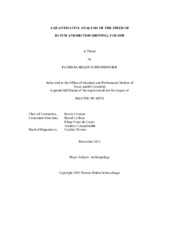| dc.description.abstract | The period 1730-1850 brought no major revolution in the design of wooden ships. Yet the origins of naval architecture and the beginnings of scientific understanding of hydrostatics and hydrodynamics can be traced to this time. Accordingly, scholars have debated whether this period saw any significant improvements in the quality of ship designs. This study examines changes in length, tonnage, day’s run, and speed-length ratio for British and Dutch ships built during the years 1730-1830 (British) and 1750- 1850 (Dutch) through regression analysis. Data for this study is taken from the Climatological Database of the World’s Oceans (CLIWOC), which contains the daily entries from thousands of logbooks for voyages 1750-1850.
British naval vessels gain in size and speed, but only 3rd rate vessels gain in speed-length ratio. This shows significant improvement in ship design, but suggests that speed under sail was not a primary objective of naval shipwrights. Length and tonnage were not available for Dutch naval vessels, but speed shows a significant, quadratic gain. The quadratic factor is likely due to the Netherlands taking a belligerent rather than neutral role in the later wars, which required the construction of larger vessels. British naval vessels are faster on average than Dutch naval vessels, but also probably larger on average. No national difference is found in the speed of frigates.
Length does not increase for British merchant ships (largely East India Company (EIC)), but tonnage, speed, and speed-length ratio do. Dutch merchant vessels prior to 1800 (largely Dutch East India Company (VOC), with a few vessels from the West Indies Company, Middleburg Commercial Company, and private traders), show no increase in size or speed. After 1800, Dutch merchant ships’ speed increases until it matches that of British merchants. The VOC heavily regulated ship dimensions, and the data shows that this effectively suppressed improvements in Dutch ship design. Where standardization was absent, substantial gains in size and speed were achieved. | en |


